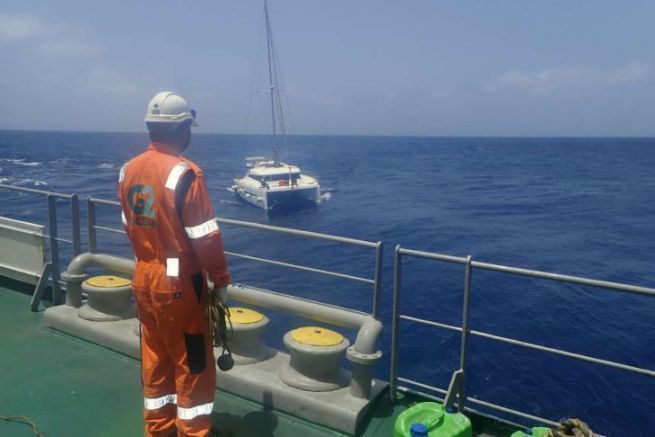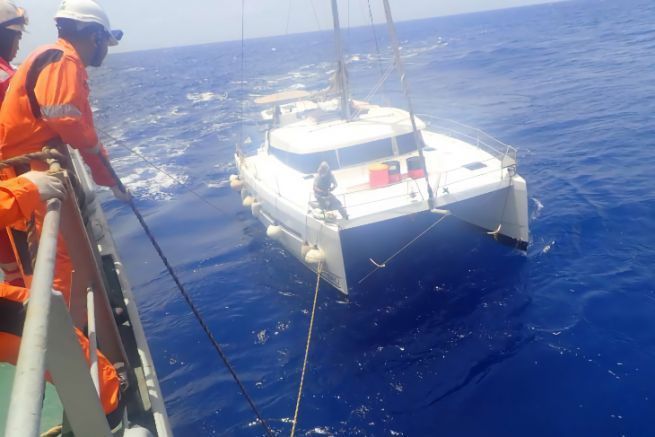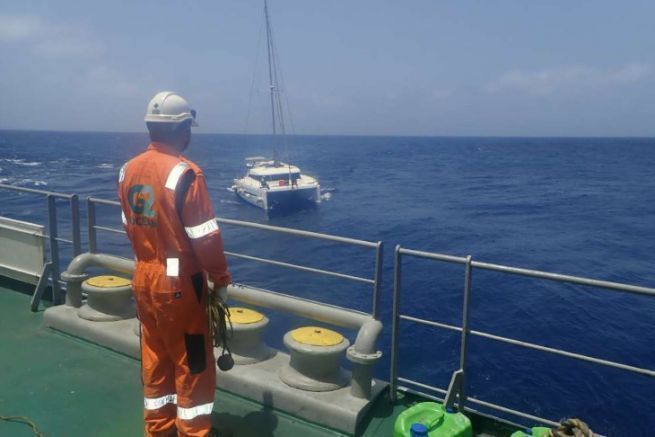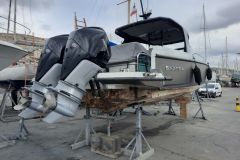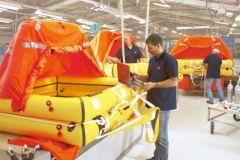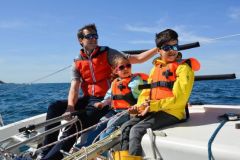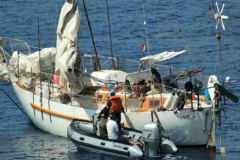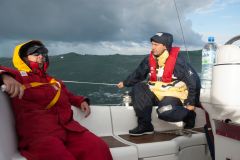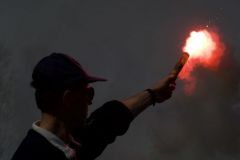Sunday, April 4, 2021
I go to launch a "Pan-Pan" on VHF channel 16, which remains unanswered, then I contact the CCMM by Iridium. I try to be clear, to give precise information. I apply the protocol that I learned by reflex in the confusion that is mine‚euros¶ I am put on hold‚euros¶ I cut the communication. The CCMM will not bring me anything. I dial the CROSS number. "You are calling for a sea emergency‚euros¶" then finally an interlocutor who seems competent, I explain the situation to him, I understand that he understands what I am saying‚euros¶ I tell him that I have to go help the other crew member and that I will call back.
Yves was able to lower Marc completely, who is lying on the bimini near the mast step. I can only note his death. I call back the CROSS.
We secure the boat, we check that there is no end in the water. Yves secures the bome by attaching it to the bimini. We put the boat back on the engine and decide to head for Cape Verde, the closest land, but to windward. There is also the possibility to sail downwind, but it is much further and we only have the solent so no hope of speed‚euros¶
There are two trawlers so men not far from us, towards the East. We see them on the AIS. They don't answer the VHF, because they are probably out of range, but maybe they can help us, it's our only hope. Maybe they can give us fuel, because we don't have enough to reach Mindelo which is 750 nautical miles away. Finally, bring us some comfort‚euros¶
We decide to leave towards the North-East, with the wind, but as close as possible. We set the solent, a motor. We spend the night in the saloon, without speaking much. I still have to manage the boat by trying to use the sail and an engine, to go towards the trawlers which represent life, help...
Monday, April 5, 2021
At about 0:00 am, I received a call from the CROSS, which was considering diverting a cargo ship to pick us up, and told us that we would have to abandon our catamaran. I can't consider this solution. I try to move forward as best I can with an engine and the solent, but we are on a course that leads nowhere and no speed. I tried all possible combinations of heading and sail trim, but nothing made the boat go any better. The CROSS asks me again if we want to evacuate the boat, as they can divert a cargo ship: I answer that, for the moment, I am not considering this solution at all. I have trouble using the Iridium, it was always Marc who did it. I only know how to send SMS to my wife Vanessa. I am discovering the other functions with difficulty, but it is essential to be able to communicate.
The CROSS advises me to send frequent calls to the VHF channel 16, the trawlers are 10 nautical miles away, they must hear me, but the "Mayday, Mayday" do not trigger any response‚?¶ I hope to be able to cut off one of these trawlers, the SHOEIMARU nį1, but the wind refuses‚euros¶ √euros 6h45 Vanessa relays to me the message from the CROSS: "The trawlers in front of us are Japanese and do not have diesel compatible with our engines‚euros¶" I receive a message that there is a boat 35 miles from us, the POLAR PACIFIC . We will never see it, have no echo on the AIS and never hear it on the radio.
We calculate the remaining autonomy: we would have to recover 800 l of diesel in the middle of the Atlantic! The Iridium does not work anymore. After insisting, I finally understand that the reception box is full. I empty it and the Iridium works again after I have deleted all the messages. I exchange messages with Vanessa. The situation is really not brilliant‚?¶ The sea is getting rougher and we are forced to put both engines, as we are dragging ourselves at 1.5 knots.
Now we are at 4 nd, but the diesel consumption is double‚euros¶ √euros 14:50 on April 5, 2021 message from Vanessa: a tanker can give us 600 l of diesel in 4 h! That gives us back the morale‚euros¶ The CROSS confirms, refueling by the tanker CORAL TOPAZ, but in 10 h, that is to say in the middle of the night. The CROSS asks us to do the maneuver during the day, because the sea is well formed, 17 knots of wind. The CROSS telephones me with the weather forecast. Still at least 15 knots of wind ! The possibility of a diesel delivery cheers us up a bit, but we start to wonder how we are going to do it? Do they have jerry cans, barrels, how to transfer them‚euros¶ So many questions that we do not have the answer‚euros¶
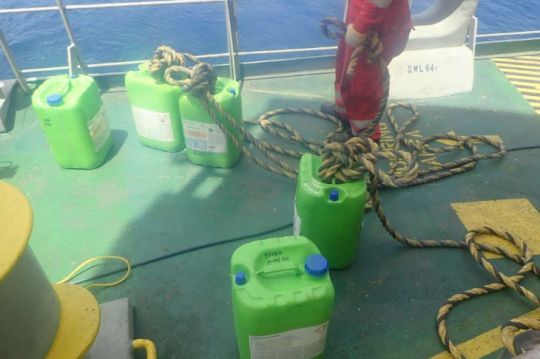
Tuesday, April 6, 2021:
0h41 on CORAL TOPAZ appears on the AIS. 02h: radio contact with the CORAL TOPAZ when it is 10 nautical miles away. I manage to understand the captain's English. I try to explain to him that I will board his port side, that I will put fenders on my starboard side where my cockpit is and that he will have to send me two mooring lines. He is very cooperative. It is a 195 m long boat that appears.
Yves tells me to prepare a waterproof container with our personal belongings and papers in case the maneuver goes wrong and we leave the boat. I start to wonder and I move to the waiting position at the helm. We both have our life jackets on and are secured on the lifeline or fixed point. I see the tanker starting to turn to board us on the starboard side as planned. We get tossed around at a standstill and I have a hard time keeping the boat upwind. I am getting pulled to one side or the other, but I am willing to show my intentions. In the dark night, without any reference point, it is not easy to hold the boat. Each time, I put my nose to the wind by presenting my starboard.
Here it is, half a mile away, almost stopped and the captain tells me by VHF that he maintains the course 005į, which will allow me to approach it while being protected from the wind. I boarded the tanker on its aft port side, it was well positioned to protect me from the wind, but not from the swell. We go up and down at least one or two meters with each wave. We skim along this wall of black steel. A sailor is waving a red lamp at me to show me where to position myself. A mooring line is thrown to us, Yves manages to catch it at the front.
As soon as she is in the cleat, I put myself in reverse gear to come and stick to the tanker, but the boat does not react‚euros¶ Finally I put myself a little in the way by reversing the throttles and the catamaran comes to stick to the tanker. I ask again for a back mooring line on the radio. A sailor ends up throwing it to us, Yves puts it in the cleat. Here we are, we are stuck to the boat, the fenders are crushed against the hull of the tanker. The sailors signal us to move the boat forward, because we are not under the crane. It takes us some time to make them understand that, in order to move forward, they have to let go of the rear mooring line and take back the front mooring line.
Here we are under the crane after a hard fight. We see a 200 l drum rising in the air just above us! I put the throttle on, reversing the levers to better stick the boat to the cargo and I go to help Yves at the front. The drum is coming down, we are still jumping 1 or 2 m vertically along the tanker. We manage to grab the drum with Yves and the sailor puts it on the deck by maneuvering perfectly with the crane. We remove the fastening system on each side of the drum, we roll it and manage to put it upright in the front tank of the boat. We repeat the operation three times and are exhausted. The 600 l of diesel are on board! We negotiated a pump, because to pump in the barrels, we need a pump that we do not have. The team leader really doesn't want to give his pump‚euros¶ I insist on the radio to the captain and they bring us down the pump in a bucket, with a body bag. We thank them, exchange big signs, then the mooring lines are cast off, we sink back into the dark. The tanker goes back on the gas and disappears very quickly‚euros¶
I send a text message to Vanessa. It's 4:20 am and it's Tuesday, April 6th. It's been two full days since we have slept a single minute. We spend the day transferring the diesel from the drums to the tanks. We do this with a 10 l can, being tossed around and even regularly sprayed by a wave. We finish exhausted at 4 pm, soaked and smelling diesel, but without having lost any! We filled the two tanks of our boat.
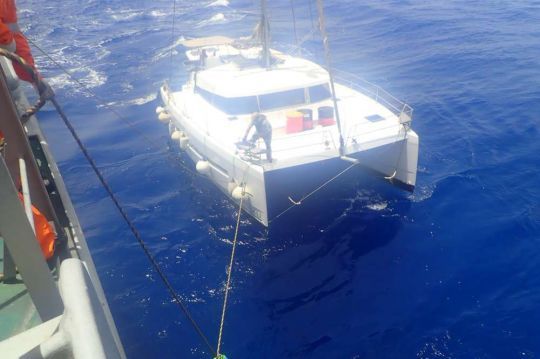
Wednesday, April 7, 2021:
We share the night with Yves and get some sleep, a few hours each. At 3 am, the CROSS calls us to give us an appointment with the STAR MAJESTY At 9:30 am to transfer the body. After talking with Yves, we refuse, because the sea is too rough. We try to put the solent, but it slows us down rather than the other way around¶ We roll it up. We put 50 l of diesel in each tank with our small 10 l jerry can. This is not going fast, but our method is well developed now and we are efficient. Suddenly the engine stalls! Yves goes down in the engine hold, asks me for a 13 and a 17 key. I go to get them, he opens an injector: no more diesel! He looks for it and asks me if I have a diesel filter. I go and get one and he changes it. The engine sputters, starts on two cylinders, then starts again normally‚?¶
At 11:30 am the STAR MAJESTY calls me via Iridium and we agree that the sea is really too big to attempt a transshipment of the body. The captain seems very cooperative and I also manage to understand him in English, which is not negligible. Suddenly, the AIS icon of the STAR MAJESTY appears behind us. Obviously it is coming to meet us. We establish a VHF contact and he offers me 150 l of diesel, which we accept.
The sea has calmed down a bit and at 3 pm we start the maneuver. They bring down the jerry cans one by one and Yves grabs them. They are still 40 l each. I try each time to position myself as well as possible, but it is not easy. The hull of the boat is very leaky and I have to get under it. I am poorly protected from the wind and the swell because of the shape of the boat. I scrape the hull once or twice‚euros¶ We have the 6 cans and after thanking them well, we move away as fast as possible to resume our route. Really risky maneuver!
At 4:33 pm the CROSS calls us to check the situation: it seems that we have enough diesel to reach at least the proximity of Mindelo, everything is fine on board. This little daily maintenance shows us that we are not abandoned and raises our morale. I insist on having an "administrative" assistance when we arrive in Mindelo.
Thursday, April 8, 2021:
We empty the last barrel and put in addition a can of STAR MAJESTY . He gave us a very "dense" diesel, which risks clogging the filters of the engines, so we try to dilute it with more "clear" diesel to have an average‚euros¶ We make our refueling every morning‚euros¶ I manage to turn on the computer and I manage to load the weather that the router sent us. Yves changes the fuel filter of the starboard engine, which has also stalled.
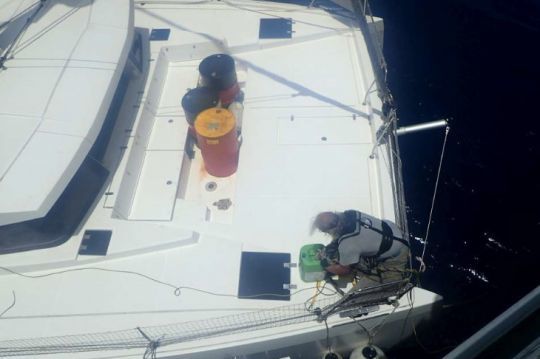
Friday, April 9, 2021:
I take 3į more North to try to avoid an area where there is a bit more wind. I let Yves sleep until 5 am, then I go to sleep in turn. We are making good progress, the sea is calm, the wind is 9 to 10 knots. The boat is not slamming anymore, we are making an average of 5.2 knots, we are making good progress. The CROSS considered the possibility of a supply by a CMA CGM cargo ship, but in the evening the wind picked up and waves appeared. We did not take up this offer after discussing it with Yves. Normally, we have enough fuel to go very close to Mindelo, so there is no unnecessary risk in boarding a large cargo ship in heavy seas. The CMA CGM SAINT LAURENT we were overtaken at 18.5 knots and passed at 0.5 nautical miles without radio contact. We really don't want to try a collision with a cargo ship in 18 knots of wind. After 6 days, as fatigue accumulates, we feel that the risks are increasing. It would be silly to crash now when we have almost enough to get back or to get close to the coast!
The wind picks up quite strong, up to 20 knots, which slows us down considerably. The boat is taking a lot of hits while falling back in a hell of a noise. Seawater enters through the shower drain on the starboard hull, and we have to activate the shower drain every 4 hours. I reduce the engine speed a little to be as economical as possible, and type as little as possible. The computer breaks down‚euros¶
Saturday, April 10, 2021:
I go to bed at 4 am. I wake up at 9 am, the boat is working better, the wind has dropped a little, we have only 11 knots of headwind and we are making better progress. We think about the different solutions by exchanging with Vanessa and the CROSS: the gauges are very difficult to interpret, given all the movements of the boat. The best thing seems to be to keep going straight ahead, the closer we will be to the coast, the more we will be helped. We have consumed more diesel than expected, the headwind being stronger. I fix again the computer, which allows us to have the AIS on the screen of the square and avoids us to go up to the helm. Always the anxiety of the diesel‚euros¶ We do not know how much we have in the tanks, the gauges moving constantly given the movements of roll and pitch of the boat.
At 5 pm the Iridium rings: the CROSS proposes us a refuelling with a 225 m long cargo ship at 9 pm UTC. After talking with Yves, we accept. Obviously our fuel level is getting lower and lower and we have no choice. At 9 pm, no boat on the horizon. Vanessa tells us that it will be later. At 2:40 am we see appearing behind us on the AIS, a Chinese cargo ship, the HUAXING HAI. We have confirmation by Vanessa, it is indeed him who supplies us. He offers us 150 l of diesel. This will allow us to reach Mindelo without any problem. I can see him getting closer, he is moving at 12 knots and catching up with us quickly. When he is 10 nautical miles away, the range of our VHF, I establish radio contact. I explain to him in English how I would like to do the maneuver. The captain is very cooperative and accepts my proposal without any problem. This is the third time we have done this maneuver and I am getting to know it.
The HUA XING HAI arrives in the night, I see her slowing down with the AIS, she gets into the wind and then turns slightly on her port side. Now he is in position and I board him on his port side by our starboard side. The sales area is perfect on her stern, finally a little calm. A sailor throws a mooring line, Yves puts it on the front cleat and I put the port engine astern. The boat moves backwards and the dark wall of the cargo ship is closer and closer. As usual now, I put the starboard engine forward to swivel and I see the mooring line fall off the boat. The sailor probably didn't hit it‚?¶ I hear the screams of the sailors running on the deck of the freighter. I immediately unhook the propellers and yell to Yves to pick up the mooring line very quickly. The mooring line in the water and the propellers are dangerous. The wind and the swell move us away from the cargo. Here we are, Yves has recovered the mooring line. We can start the maneuver again. This time, I can lean on the mooring line before the sailors launch us! It is well fixed on the cargo. The catamaran swings under the effect of its engines, Yves grabs the rear mooring line, hits it on the rear cleat. I leave the engine levers engaged and reversed to stay on the cargo. The fenders crash against this 6 or 7 m high wall, along which we make the elevator. The Chinese sailors begin the transhipment of the diesel: they put it in bottles of 5 l of frying oil, they take them down to us two by two‚euros¶ We catch them in turn and I go to put them between the barrels in front. They pass us about twenty of them, then 3 cans of 40l. They ask us by radio if we need anything else, water, food. After a sailor, I make a sign to bring my hand to my mouth as if to smoke. He signals me to wait, then comes back with two cartons of cigarettes that he puts in a bucket and takes them down to us. It's a small gesture, but it's a warm feeling!
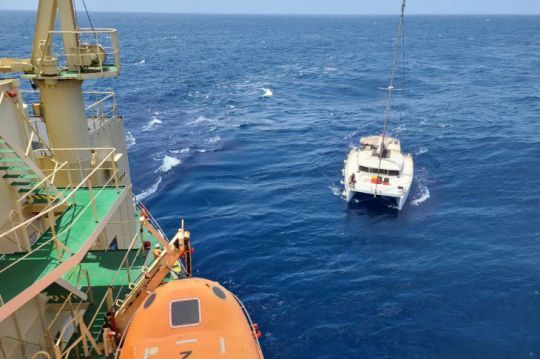
Sunday, April 11, 2021:
I manage to sleep a little, the sea is calm until noon and we pass the symbolic 100 nautical mile mark of the arrival. We are reassured on the diesel, but the two red lights of load of the engines are lit. The wind picks up, from the front as always, reaches 20 knots, the waves form, the speed drops‚euros¶ The boat hits the big waves quite hard, from time to time the starboard engine alarm starts to sound, the lap counter marks 0, but the engine is running‚euros¶ Then it starts again‚euros¶
We see the island of Santo Antao appear. The wind does not weaken, we drag ourselves at 4 knots‚euros¶ The shrill noise of the engine alarm freezes me every time. We are still moving forward, but the last few hours seem endless‚euros¶ I slightly reduce the throttle to avoid the boat hitting too hard on the wave trains. The night falls, I exchange some SMS with Vanessa, who warns us of wrecks in the roadstead. I only have the iPad as a map to get back home, as the steering screen is degraded. I round the entrance, pass between the wrecks and we enter the roadstead. The wind and especially the waves are calming down as we move forward.
The control center of the port of Mindelo calls me on the VHF and gives me the geographical coordinates of the berth. Yves manages to enter them in his phone and it gives us a place inland‚euros¶ We go towards the bottom of the harbor, it can only be by there ‚euros¶ I pass a VHF message to ask where to go and obviously he does not have the answer. He points out a flashing orange light, which I think I see. I go towards it avoiding wrecks and wet boats without lights. There are no markers. Yves is at the front and watches, the starboard engine alarm screams from time to time. I see a police flashing light, I go towards it and the harbour controller calls me back to tell me to go to the police car.
Here we are, I start the boarding maneuver behind a small cargo ship. There are at least 20 people waiting for us along the quay. I am forced to board on starboard because of the position of the helm, so I arrive in reverse gear. Yves passes the two mooring lines. We are now at the quay. We secure the boat by putting two more mooring lines. I can't even make a chair knot anymore‚?¶ The French consul and the police come to see us.
Monday, April 12, 2021:
The policemen arrive at 9 am with the French consul as a translator, give us back the documents, ask us questions to understand the events, then leave asking us to report our movements and ask us to do the formalities of arrival - Border Police and Maritime Police. We leave for the marina where we moor on the docks. I am obliged to change berths, because at the first one the lines are not good‚euros¶ I do not need to stop the starboard engine when the lines are tight, it breaks down‚euros¶ We will see that it is because of a fuse not "melted", but probably broken because of the shocks of the waves...
